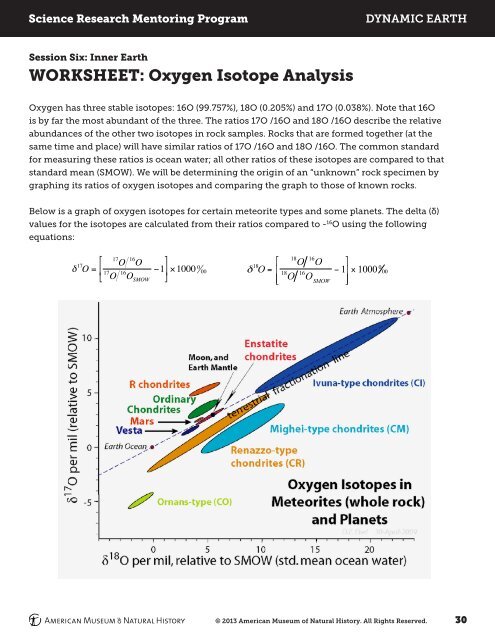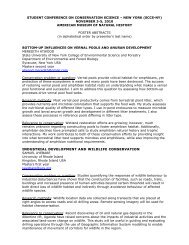SRMP Dynamic Earth Curriculum - American Museum of Natural ...
SRMP Dynamic Earth Curriculum - American Museum of Natural ...
SRMP Dynamic Earth Curriculum - American Museum of Natural ...
Create successful ePaper yourself
Turn your PDF publications into a flip-book with our unique Google optimized e-Paper software.
Science Research Mentoring Program<strong>Dynamic</strong> <strong>Earth</strong>Session Six: Inner <strong>Earth</strong>WORKSHEET: Oxygen Isotope AnalysisOxygen has three stable isotopes: 16O (99.757%), 18O (0.205%) and 17O (0.038%). Note that 16Ois by far the most abundant <strong>of</strong> the three. The ratios 17O /16O and 18O /16O describe the relativeabundances <strong>of</strong> the other two isotopes in rock samples. Rocks that are formed together (at thesame time and place) will have similar ratios <strong>of</strong> 17O /16O and 18O /16O. The common standardfor measuring these ratios is ocean water; all other ratios <strong>of</strong> these isotopes are compared to thatstandard mean (SMOW). We will be determining the origin <strong>of</strong> an “unknown” rock specimen bygraphing its ratios <strong>of</strong> oxygen isotopes and comparing the graph to those <strong>of</strong> known rocks.Below is a graph <strong>of</strong> oxygen isotopes for certain meteorite types and some planets. The delta (δ)values for the isotopes are calculated from their ratios compared to - 16 O using the followingequations:$ 17 O 16 O '18 16O O" 17 O = %17 O 16 ) *1000 0 00 δ 18 O18 161 1000 0 00O SMOW (= ⎡⎡O O −⎤⎤⎢⎢⎥⎥⎣⎣⎢⎢SMOW ⎦⎦⎥⎥ ×!© 2013 <strong>American</strong> <strong>Museum</strong> <strong>of</strong> <strong>Natural</strong> History. All Rights Reserved. 30
















